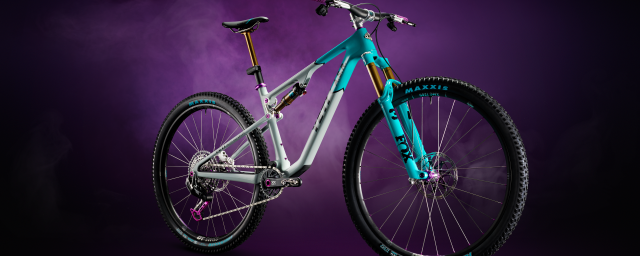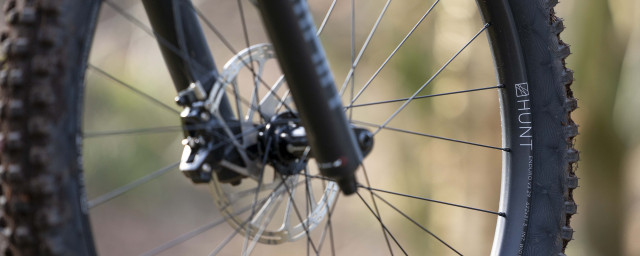
- Great ride quality
- Light and stiff
- Wide tyre clearance
- Pricey
- Mud shelf behind bottom bracket
The Ibis Hakka MX provides a smooth and fast ride with great handling and space for wide tyres and versatility by way of mudguard mounts, and it’s light on the scales, but it is a pricey prospect in a competitive marketplace.
- The best gravel and adventure bikes you can buy for under £1,000
- Five things that weren't cool - until gravel happened
- Buyer's guide to mountain bike and gravel shoes - flat and clipless option
While probably best known for its mountain bikes (it’s one of the oldest mountain bike brands having been founded in 1981, before most of you lot were born I bet?) Ibis isn’t immune to the charms of the growing adventure category and two years ago redesigned its cyclocross bike into a much more capable adventure and gravel bike.
It still retains some of that cyclocross DNA. The ride is fast and direct with the geometry not as slack or stretched as some more progressive bikes in this burgeoning adventure and gravel category. If you want to race CX on a Sunday and ride gravel on a Monday, the Hakka MX would be a good choice.
From the similarly dropped chainstay to increase tyre/crank clearance to the geometry, there’s more than a passing resemblance to the genre-defining Open UP, the bike that most leapt to mind when riding the Ibis. That’s no bad thing; the UP is one of the best carbon adventure bikes I’ve ever reviewed. The Ibis does have longer chainstays, wheelbase and a steeper hand angle that provides a really nice blend of quick steering but stability on loose rocky surfaces.
Like the Open UP, the Ibis is light and stiff and that means, if you like getting a good return on your energy investment, it’s a rapid bike and very efficient at translating your energy into forward motion. It takes very little effort to keep the Ibis rolling along the road and dirt paths, and when it comes to climbing the 8.3kg (18.2lb) weight ensures it can scamper up even the steepest technical ascent, provided it’s not damp enough to find the traction limits of the tyres.
It’s pleasantly composed on rough surfaces as well, no doubt helped by the 40mm wide G-One tyres which, if run at 30-45psi to suit different ground conditions, can isolate you from the bigger impacts whilst still retaining good rolling resistance properties. It’s a really good tyre for crossing the divide between road and dirt and while it’s no master of any particular terrain, it’s never overly compromised.
Frame details
The carbon frame weighs a claimed 1kg and provides clearance for up to 700x40c (as tested) or 650b x 2.1” tyres. Mud clearance is also generous but the shelf behind the bottom bracket does collect crud a bit too easily though it never actually clogged up on the muddier rides.
It is a smartly designed and well-appointed frame and an ENVE carbon fork is slotted into the head tube, going some way to justifying the price. Disc brakes, naturally, with flat mount callipers and internal routing. You get mudguard mounts on the frame, but sadly none on the ENVE fork which is a bit rubbish, to put it bluntly.
The fork is also showing its age with the post mount disc brake interface, with most new road and gravel bikes adopting the flat mount standard.
UPDATE: We've just been notified that Ibis is updating framesets with the latest Enve fork which includes a flat mount disc brake and mudguard eyelets.
You don’t get any extra bottle cages but Ibis has wrapped the downtube with a protective sheath to protect the carbon against rock and stone strikes.
The 'hand job' is a nice nod to the cable hanger on early Ibis bikes before disc brakes took over, with it now serving as a mudguard mount.
There’s full internal cable routing and while the test bike came fitted with a 1x groupset, you can still fit a front mech should you desire. Inside the downtube is a custom Di2 battery mount accessed via a trap door and outside is a protective cladding to protect from rock strikes. The frame will even accept a dropper post if you want to go full gnar!
Ibis has adopted the T47 bottom bracket first developed by Chris King and Argonaut Cycles a handful of years ago. It has the same diameter shell as a Press-Fit 30 bottom bracket, but with the threaded cups of a traditional BSA-threaded bottom bracket. The benefit is an oversized bottom bracket so the chainstays, seat tube and downtube can be correspondingly oversized, while the threads permit easy installation and should prevent press-fit creaking issues.
Build and equipment
The pictured test bike costs £3,349 and for that, you get a full SRAM Rival 1 groupset with a 40T chainring and wide-range 10-42T cassette attached to Stan’s Grail aluminium tubeless wheels and shod with excellent Schwalbe G-One Allround 700x40c tyres. All the finishing kit, bar the WTB saddle, comes with Ibis branding.
SRAM’s Rival 1 groupset is a common choice on a wide range of gravel bikes, from the most affordable aluminium bikes to high-end carbon steeds like this Ibis. It works well, the large hoods are good anchors to plant your hands against on steep terrain, and the gear range is effective in a wide range of scenarios, and the brakes are as powerful as you need for maximum control.
The G-One Allround tyres are a lower profile offering in the G-One range and well suited to lots of road riding interspersed with hardpack off-road tracks, gravel tracks and bashing across the plain. They’ll struggle in the gloopiest mud but you’ll be surprised just how much you can push them in muddy conditions if you’re delicate with weight balance and power output. Run them at 35-40psi and they’re good for whatever terrain you’ll encounter.
The Ibis aluminium handlebar and stem complement the frame nicely, but a carbon bar might be nice at this price. Also, while I’m no massive fan of extreme flared drop bars, a slight flare to the drops might have been appreciated for technical trails and to get away from the roadie focus.
You could always buy the frame and fork for £2,099 and build it up with your own parts, or spend more - a lot more - and get a Shimano Ultegra Di2 groupset with Ibis carbon wheels for £6,099. Worth knowing is the 7-year warranty on the frame.
Rivals
It’s a lot of bike for a lot of money. For £350 less you could lay your hands on the similarly specced Bombtrack Hook EXT-C, which also combines a carbon frame with big tyre clearance and an SRAM Rival 1 groupset, and while there’s similar ride quality, it could be argued, subjectively of course, that the Ibis is a better-looking bike. There’s also 30 years of heritage with the Ibis.
For another £100 you could look at the Specialized Diverge Comp which gets the Future Shock for really smashing gravel tracks and potholes.
And if you don’t mind swapping carbon for aluminium, you could consider the Nukeproof Digger which gets the same SRAM Rival groupset and costs just £1,850.
Verdict
Judged on its own, the Ibis Hakka MX is a fast and very capable bike that leans towards thundering along roads, gravel tracks and singletrack rather than ambling through the undergrowth. The low weight and stiff frame begs to be ridden and raced hard and fast so if you have an eye on some fast solo bikepacking quests or gravel races, this could be a bike worth taking a closer look at, provided you don’t mind paying for it.





















2 comments
You suggest the Nukeproof Digger Pro as an alternative with SRAM Rival, but having spent 3 months trying to buy one I can assure you that they're not available. The supply isn't meeting demand, a real pity as it ticked all the boxes for me and looked beautiful.
Instead, I eventually purchased an Orange RX9 Pro, the 2018 model was full SRAM Rival 1 and discounted. Less than £1.5k with alu frame, carbon fork and full SRAM Rival 1 with hydro brakes and 700x42c wheels. It's a beast and I love it and would recommend it to anyone.
I've had mine for over a year now after moving up from a GT Grade Ultegra. It was a bit cheaper then, and I went with SRAM 1x and 650B option. At the time I spent a long time looking at the options. And for me, it came down to a choice between this, an Open Up(per), Kinesis Tripster or Salsa Cutthroat. The Up lost because of the Press Fit, and I seem to remember it was a bit more restricted on tyre size. The Tripster because of small tyre sizes. The Cutthroat because it was Press Fit and it looked like getting hold of one was going to require waiting far far too long.
The worst thing about the bike is that the frame leaks, and it doesn't drain unless it is hung by its front end with the mudguard eyelets removed. When it's wet and muddy, this leads to a bottom bracket that needs very regular regreasing not to disintegrate.
The mudshelf, at least with the 650B's, is more of an aesthetic annoyance. It's not typically where it clogs. Usually, the clogging problems I've encountered have been between the sidewalls of the tyre and the frame. The solution to which is to run a "smaller" 2.0" (or even smaller) mud specific mountain bike tyre and max out the clearance.
Aside from the lack of Press Fit and its creak, the best thing about the bike is the wheel size and its tyre clearance. Having the 650B size and clearance gives access to a large, well reviewed and highly capable pre-existing catalogue of MTB tyres. Long distance bike packing pop the 2.1" Tour Divide proven Vittoria Mezcal's on. Muddy swamp fest that'll be the 2.0" Maxxis Beavers. Dry and not very technical 2.1" Schwalbe Thunderburts, and so on. Even without including 700C in the mix, the range of tyres makes the bike incredibly flexible in what it can competently tackle.
In the year I've had it I've ridden thousands of miles on many different types of terrain. With the right tyres and pressures, on-road it's fast enough, and its capabilities off-road far exceed my bottle point. I've not seen anything that I think looks better and if I was unlucky enough to require a replacement, I'd be very likely to buy the same again.
Sorry to sound like a bit of a fanboy, but it really is a very nice bike